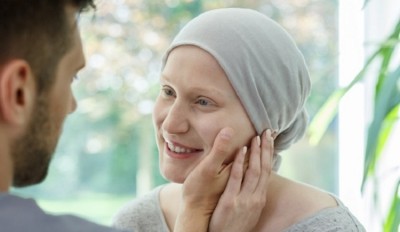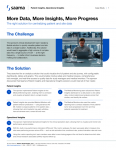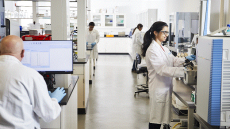Getting cancer trials back on track after COVID-19

Marie Lamont, president and COO of Inteliquet, recently spoke with Outsourcing-Pharma about how the COVID-19 pandemic impacted the work of oncology study sites and sponsors, as well as the strategies and solutions that could help the important work of such research teams continue.
OSP: Could you please talk about how COVID-19 has impacted oncology trials? How many have been paused and have had trouble starting back up again?
ML: We have yet to see the definitive analysis, but the picture that’s developed across multiple reports and surveys is somber, at best. The Lancet recently reported that the pandemic resulted in a 60% decrease in new clinical trials for cancer drugs and biological therapies.
A survey published in JAMA Oncology in November found that 20% of responding cancer patients were less likely to enroll in clinical trials due to the pandemic. Those respondents also said they were likely to avoid clinical trials until the pandemic is over. These findings are serious when you consider that, in the early stages of the pandemic, a 41% decline in trial participation was reported in April 2020 compared to the same time in the prior year. GlobalData found that less than 40% of oncology trials had resumed since the pandemic started.
If we look beyond oncology, more than 1,200 clinical trials worldwide ended because of the pandemic, according to TranspariMED. At one point last year, between 60 and 100 biopharma organizations around the globe paused clinical trials.
OSP: Are oncology trials more difficult to recruit for than other studies?
ML: The traditional process for patient matching and enrollment for clinical trials before the pandemic resulted in less than 5% of adult cancer patients participating in a trial. That was before the pandemic. Pandemic-related delays and closings reduced participation even further.
All clinical trials start with feasibility assessments to determine where clinical trials have the best chances of enrolling patients. Oncology trials have high hurdles, however.
When a trial sponsor approaches a cancer center in search of patients for clinical trials, they begin with a feasibility survey questionnaire (FSQ). To complete it, physicians, research directors, and primary investigators must sift through the proposed protocol components which include multitudes of cancer biomarkers, patient traits involving their treatment and, importantly, the progression of their cancer, genes and other factors
This process is time-consuming and complex. As many as 20,000 permutations or combinations of these must be reviewed to determine if a patient is eligible for an oncology trial.
If you followed the 2021 Cholangiocarcinoma Foundation Annual Conference, for example, the experts focused on oncology clinical trials and how even a successful approval can be a long time coming.
Dr. Susan Pandya of Agios Pharmaceuticals went on record describing the ClarIDHy study. It was a randomized Phase Three trial of Ivosidenib. The therapy, previously approved for the treatment of acute myeloid leukemia with IDH1 mutation, was in the Agios study being examined for its potential for cholangiocarcinoma with the IDH1 mutation.
Agios’s consideration of Ivosidenib’s utilization for cholangiocarcinoma began in 2014 with a Phase One study. AGIOS just submitted a supplemental new drug application this past February. That’s actually a great result, but it’s too often a rare one.
Biopharma companies seeking to operationalize a study like this one involving a specific cancer face a host of challenges. Feasibility is a hard gate to pass through for both study sites and sponsors.
OSP: Could you please talk about how COVID-19 has impacted cancer diagnoses, with tests, screenings, and other procedures being put off?
ML: Unfortunately, we can expect more diagnoses of more serious cases of cancer due to procedures being put off. It’s another example of the tragic toll of the pandemic.
Dr. Ned Sharpless, director of the U.S. National Cancer Institute, estimated there could be nearly 10,000 excess deaths over the next decade due to delayed detection and treatment of breast and colon cancers.
According to JAMA, delayed doctor visits have resulted in a dramatic decrease in the weekly rate of new diagnoses for six common cancers, including breast cancer. In March and April, rates declined by about half when compared to the first two months of the year when the pandemic was in its early stages.
IQVIA data shows 22m people postponed cancer screening tests and 80,000 patients delayed or missed diagnoses.
Not only does this mean that fewer people are being diagnosed with cancer, and therefore not even on the radar for clinical trial participation, but it also means that by the time they do get a diagnosis, their disease may have progressed and will require more care.
OSP: You describe the traditional recruitment and enrollment processes for such trials as “painstaking and unsatisfactory.” Could you describe how?
ML: Numerous stakeholders play a role in determining who can join trials – pharmaceutical companies, contract research organizations, hospitals, doctors, and even the individual patient and their family. Cancer center research staff must often interface and coordinate among these stakeholders.
But center staff often work with antiquated tools. Many comb through a combination of paper records, pdfs, and electronic documents and records to manually match patients to trials with increasingly complex inclusion/exclusion criteria.
That’s unacceptable. The mammoth effort of expertise, time, and money required for those low results suggests there must be a better way. The patients are out there, waiting to be identified for a trial if we only had a better way to find them.
Inteliquet has a better way, of course, that uses clinically relevant cancer center data to match eligible patients with trials.
OSP: Specifically, how are cancer centers and oncology trial teams stymied by outdated tools?
ML: Rather than searching through haystacks for needles, research directors can use new technologies to input trial sponsors’ requirements into a system that can ingest data, structure, or normalize it for analysis and ultimately make it more usable. These technologies enable cancer centers and sponsors to immediately identify potential patients for trials. The painstaking, inefficient process gives way to instantaneous and more complete results that doctors and trial sponsors can then review.
Four benefits flow from this collaboration between hardworking people and technology. Pharmaceutical companies can enroll more patients successfully in trials when they have access to a large number of hospitals and cancer centers. Physicians have more options for their patients including clinical trials as a care option. Patients, in turn, can access more treatment options. And hospitals and cancer centers save the time and money that canceling or shutting down trials’ costs.
OSP: Could you talk about how cancer trial sponsors can work with cancer doctors and centers to bring recruitment numbers up and restart trials?
ML: Clinical research staff take approximately three hours to fill out an FSQ. Biopharma sponsors require these questionnaires to determine if cancer centers have sufficient potential patients to enroll in a specific cancer study. If staff can fill out the questionnaire in five to 10 minutes, in contrast, the roughly two-to-three hours saved unlocks time and resources for other clinical trial operations, including caring for cancer patients.
The manual method of matching patients is cumbersome because the data used to match patients to trials is in unstructured or unnormalized formats like physician notes or lab reports. It is essential but time-consuming to review this crucial information. One has to be thoughtful and accustomed to poring through it, too, depending on the site. Doctors, for example, sometimes explain the same concept differently.
Manual chart reviews are considered a necessary evil. But they delay and sometimes hinder patients enrolling in trials, even before the pandemic arrived.
We worked with one community oncology center that deployed Inteliquet’s OncWeb software platform during the pandemic to find more complete matches of eligible patients for trials. Other clinical research programs experienced a plunge in clinical trial enrollment during the pandemic.
This cancer center led to the enrollment of three times as many patients in just four months compared to the previous five months using traditional methods. Eventually, the center enrolled 10 patients from March to June 2020 – a 233% increase compared to the previous four months. They also identified three additional patients for further evaluation. That saved the trial.
OSP: Please tell us about the technologies that can help sort through data and better ID/recruit cancer trial patients.
ML: Natural language processing can comb through EMRs and other documents. Heuristic parsers learn how to read those documents. Artificial intelligence and data management make the process work.
Much of the data in clinical settings is unstructured – saved in different formats, platforms, and locations, including EMRs, scans, images, and even paper and faxes. Normalizing that data, or converting it into a structure where the information is in one searchable package, can revolutionize how we match patients to trials.
Improving the FSQ process saves significant time. We’ve seen clinical site teams spending 30 minutes a week on the process after formerly taking 24 to 48 hours a week.
The time savings are only one benefit. It’s not just about getting trials back on track, either. It’s fixing the fundamental problem that prevents trials launching. The technology provides better accuracy and the ability to forecast the number of patients in a cancer center population potentially available for trials. Teams can stop opening trials that must later close due to lack of eligible patients. They can open the right trials on the first try.
That means healthcare organizations can address the needs of trial sponsors with precise answers quickly. A team can say they have 200 potential patients for an oncology study who have been diagnosed with Stage 3 and Stage 4 lung cancer, for example, and whether they are a certain age and are PD-L1 positive or negative. They probably won’t enroll all 200 patients, but they can begin the process. That’s much more manageable than reviewing thousands of charts.
Eliminate the friction and you have more options for clinical trials that pass the feasibility stage faster. Clinical sites then gain the opportunity to redeploy resources elsewhere. My time at Inteliquet has shown me the tremendous power being unlocked right now as more healthcare organizations and clinical trial sponsors save time.
OSP: Why does turning cancer doctors into trial partners make sense? How does this shift benefit various stakeholders?
ML: Fortunately, doctors and cancer centers can give pharmaceutical companies the key to recruiting and enrolling patients in clinical trials – the data that they and their research assistants and staff already generate in their daily workflows through physician notes, procedure histories, lab, and diagnostic reports and other information in EMRs and elsewhere. The challenge, however, is that the data is overwhelming and inconsistently captured, making it extremely difficult to efficiently harvest and analyze.
OSP: Do you have anything to add?
Patient trials are the future of medicine. That future is under threat. Cancer centers and pharmaceutical executives now have the tools to save it.



















